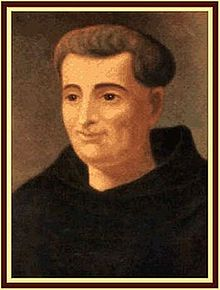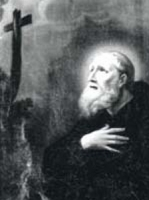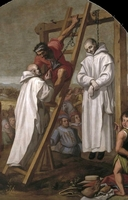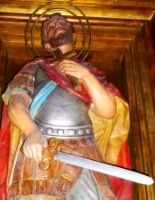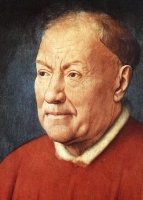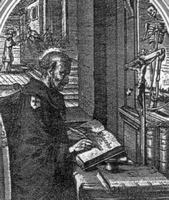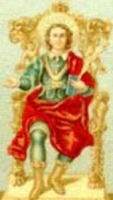Bl. Albert of Bergamo
Born 1214
Villa d'Ogna, Bergamo, Commune of Milan
Died 7 May 1279 (aged 65)
Cremona, Commune of Milan
Venerated in Roman Catholic Church
Beatified 9 May 1748, Saint Peter's Basilica, Papal States by Pope Benedict XIV
Feast 7 May, 11 May (Dominicans)
Attributes religious habit of a Dominican terciary, dove
Dominican tertiary and miracle worker. Albert was a farmer living near Bergamo, Italy, where he became a Dominican Third Order member. Married, he was a champion of the poor in his hometown of Ogna. Sometime in his adult life, Albert went on a pilgrimage to the famous shrine at Santiago de Compostela in Spain. He also visited Rome and Jerusalem, perilous journeys in his era. After his pilgrimages, Albert settled in Cremona, Italy, where he became known for his piety and for his many miraculous works to benefit others.
St. Odilo of Cluny
Born c. 962
Died 1 January 1049
Venerated in Roman Catholic Church
Eastern Orthodox Church
Feast 11 May; 19 January (Cluny); in Switzerland on 6 February.
Abbot A member of a noble family in Auvergne, France, he entered the Benedictine monastery of Cluny about 990 and received election as abbot in 994. He was beloved and respected throughout Europe for his deep austerities and his concem for the poor. In 1006, he even sold treasures of the Church to feed the poor during a famine. Through his efforts, the monasteries belonging to Cluny increased from thirty seven to sixty five. He also helped bring about the Truce of God and the feast of All Soul's Day, and was a trusted advisor to popes and kings. He was devoted to the Blessed Virgin Mary and to the Incarnation. Fulbert of Chartres called him Archangelus Monachorum, Archangel of Monks. Odilo died on January 1 while touring his monasteries.
Odilo of Cluny (c. 962 – 1 January 1049) was the fifth[1] Benedictine Abbot of Cluny, holding the post for around 54 years. During his tenure Cluny became the most important monastery in western Europe. Odilo actively worked to reform the monastic practices not only at Cluny, but at other Benedictine houses. He also promoted the Truce of God whereby military hostilities were temporarily suspended at certain times for ostensibly religious reasons. Odilo encouraged the formal practice of personal consecration to Mary. He established All Souls' Day (on 2 November) in Cluny and its monasteries as the annual commemoration to pray for all the faithful departed. The practice was soon adopted throughout the whole Western church.
Bl. Antonio de Sant'Anna Galvao
Born 13 May 1739
Guaratinguetá, Brazil, Portuguese Empire
Died 23 December 1822 (aged 82-83)
São Paulo, Empire of Brazil
Venerated in Roman Catholic Church
(Order of Friars Minor and Brazil)
Beatified 8 April 1997, Rome by Pope John Paul II
Canonized 11 May 2007, Campo de Marte Airport, São Paulo, Brazil, by Pope Benedict XVI
Major shrine Monastery of Light,
São Paulo, Brazil
Feast 11 May[1]
Patronage World Youth Day 2013
Saint Anthony of Saint Ann Galvăo was a Brazilian friar of the Franciscan Order. One of the best-known religious figures in Brazil, renowned for his healing powers, Galvăo was canonized by Pope Benedict XVI on May 11, 2007, becoming the first Brazilian-born saint. Overall, he is the second Brazilian saint, after Italian-born Saint Paulina, canonized in 2002.
Anthony of St. Ann Galvão, O.F.M. (Portuguese: Antônio de Sant'Anna Galvão, IPA: [ɐ̃ˈtõɲu d(ʒi) sɐ̃ˈtɐ̃nɐ ɡawˈvɐ̃w]), commonly known in Brazil as Frei (Friar) Galvão (IPA: [ˈfɾej ɡawˈvɐ̃w]; May 13, 1739 – December 23, 1822), was a Brazilian friar of the Franciscan Order.[2] One of the best-known religious figures in colonial Brazil, renowned for his healing powers,[3] Galvão was canonized by Pope Benedict XVI on May 11, 2007, becoming the first Brazilian-born saint.[4][5] He was the second Brazilian to be proclaimed a saint by the Catholic Church, after Austro-Hungarian-born Pauline of the Agonizing Heart of Jesus' was canonized in 2002.
St. Ansfrid
Feastday: May 11
Church Catholic Church, Eastern Orthodox Church
Diocese Archdiocese of Utrecht
In office 995–1010
Personal details
Died 3 May 1010
Bishop and founder, the Count of Brabant. Ansfrid was a courtier and friend of Emperor Otto III of the Holy Roman Empire. In 994, the emperor named him the bishop of Utrecht, although his appointment drew some local opposition. Ansfrid founded a monastery at Heiligensberg, Germany, and a convent at Thorn. He was stricken with blindness late in his life, a fate that brought about his retirement to this abbey. He is also listed as Ansfridus.
Saint Ansfried (also Ansfrid, Ansfridus) of Utrecht sometimes called Ansfried the younger (died 3 May 1010 near Leusden) was Count of Huy and the sword-bearer for Otto I, Holy Roman Emperor. He became Bishop of Utrecht in 995. He appears to have been the son or grandson of Lambert, a nobleman of the Maasgau, the area where he later founded the Abbey of Thorn. He also appears to have been related to various important contemporaries including the royal family.
Life
The principal source of information regarding Ansfried is the De diversitatem temporum by the Benedictine Albert of Metz, written around 1022.[1]
Ansfried had the same name as a paternal uncle (patruus), Ansfried the elder, a count who supposedly held 15 counties.[2] The young Ansfried studied secular and clerical subjects under another paternal uncle, Robert, Archbishop of Trier, before attending the cathedral school at Cologne.
In 961, Otto I took Ansfried into his personal service and made him his swordbearer. When Otto was in Rome the following year to be crowned Holy Roman Emperor, he directed Ansfried to keep close at hand with the sword as a precaution against any unforeseen eventualities.[3] Karl Leyser describes this as a valuable lesson in practicality.
Because of his Christian commitment, he was highly respected and an important knight of the emperor's circle, holding rich possessions along the Meuse, in Brabant and Gelderland. Possibly all or some of his counties were inherited from his paternal uncle of the same name. As Count, he had considerable success in suppressing piracy and armed robbery.[1] In 985, Otto III granted Ansfried the right to mint coins at Medemblik,[4] on the north-south shipping route through the Vlie, as well as, the income from tolls and tax collecting.[5]
Ansfridus and Hilsondis. Stained glass windows in the abbey of Thorn, 1956.
He was married to Heresuint or Hilsondis. They had one child, Benedicta. He founded a Romanesque abbey church on his wife's estate at Thorn under the patronage of St. Michael. The abbey itself had a double cloister that housed both men and women. Ansfried planned it as a place of retirement for himself and his family after he left public service. Under his control, the abbey and lands, of about 1.5 square kilometers, was reichsunmittel, making it subject only to the Emperor. Hereswitha was to be the first abbess but died on her way there; and Benedicta took her place.[6]
After his wife's death, Ansfried wanted to become a monk. However, in 995, Emperor Otto III and Bishop Notker of Liège persuaded the reluctant Ansfried to assume the then vacant see of Utrecht. Ansfried objected that as he had borne weapons as a knight, he was unworthy of the office, but the emperor prevailed. The elderly count laid down his sword on the altar of Saint Mary in Aachen and was ordained priest and consecrated eighteenth Bishop of Utrecht in the same ceremony.[6] Bishop Ansfried never took a commission in the royal army, in contrast to Notger and the Bishop of Cologne.[7]
In 1006 Bishop Ansfried founded the abbey of Heiligenberg, also under the patronage of Saint Michael.[8] Toward the end of his life he became increasingly weakened through fasting, and retired there as a monk,[6] caring for the sick, although almost blind himself.
Upon his death, townsfolk from Heiligenberg took possession of his body, while the people of Utrecht were extinguishing a not coincidental fire. The abbess of Thorn mediated and Ansfried was buried in the Cathedral of Saint Martin in Utrecht.[1]
Veneration
His feast day was 3 May but was later moved to 11 May.
Saint Ignatius of Laconi
லாக்கோனி நகர் புனிதர் இக்னேஷியஸ்
கப்புச்சின் சபை துறவி:
பிறப்பு: டிசம்பர் 10, 1701
லாக்கோனி, சார்டினியா
இறப்பு: மே 11, 1781 (வயது 79)
கக்ளியரி, சார்டினியா அரசு
அருளாளர் பட்டம்: ஜூன் 16, 1940
திருத்தந்தை பன்னிரெண்டாம் பயஸ்
புனிதர் பட்டம்: அக்டோபர் 21, 1951
திருத்தந்தை பன்னிரெண்டாம் பயஸ்
பாதுகாவல்:
ஒரிஸ்டானோ
மாணவர்கள்
யாசகர்கள்
நினைவுத் திருநாள்: மே 11
புனிதர் இக்னேஷியஸ், ஒரு சார்டினியன் கப்புச்சின் சபை துறவியும் கத்தோலிக்க புனிதரும் ஆவார். தமக்கு நேர்ந்த ஒரு தீவிர நோயின் காரணமாக தமது வாழ்க்கையை கடவுளுக்கு அர்ப்பணித்த இவர், சார்டினியாவிலுள்ள கப்புசின் துறவு மடத்தில் இணைந்து, குருத்துவம் பெறாத ஒரு துறவியானார். ஏழ்மை நிலையில் உள்ளவர்களிடம் அக்கறை காட்டியதாலும், அவரது எளிய மனப்பான்மையாலும், அவர் சார்டினியாவில் நன்கு அறியப்பட்டார். தாம் சந்தித்த எல்லா மக்களோடும் கலந்து, நோயுற்றவர்களிடம் தாராள மனப்பான்மையுடன் இருந்தார். ஆனால் அவர் தனது வாழ்நாளில், ஒரு வியக்கத்தக்க அற்புதங்கள் செய்பவர் என அறியப்பட்டார். மற்றும் அவர் தனது வாழ்நாள் முழுதும், 121 அற்புதங்களை நிகழ்த்தியதாக கூறப்பட்டது.
“வின்சென்ஸோ பெய்ஸ்” (Vincenzo Peis) எனும் இயற்பெயர் கொண்ட புனிதர் இக்னேஷியஸ், கி.பி 1701ம் வருடம், டிசம்பர் மாதம், பத்தாம் நாளன்று, சார்டினியா (Sardinia) அரசிலுள்ள “லக்கோனி” (Laconi) நகரில் உள்ள ஒரு ஏழை விவசாயி குடும்பத்தில் பிறந்தார். இவரது தந்தையார் பெயர், “மட்டியா பெய்ஸ் கடெல்லோ” (Mattia Peis Cadello) ஆகும். தாயாரின் பெயர், “அன்னா மரியா சன்னா கஸு” (Anna Maria Sanna Casu) ஆகும். இவரது திருமுழுக்குப் பெயர், “ஃபிரான்செஸ்கோ இக்னேஸியோ வின்சென்ஸோ” (Francesco Ignazio Vincenzo) ஆகும்.
தமது பெற்றோருக்கு உதவுவதற்காக வயல்வெளிகளில் உழைத்த வின்சென்ஸோ, தமது இள வயதில் தீவிர நோயால் தாக்குண்டு, மிகவும் வேதனை அடைந்தார். தமது நோய் குணமானதும் "கப்புச்சின் இளம் துறவியர் சபையில் சேர்ந்து (Order of Friars Minor Capuchin) தமது வாழ்வை இறைவனுக்கு அர்ப்பணிப்பதாக வேண்டிக்கொண்டார். இவரின் மன்றாட்டை இறைவன் கேட்டதால் இவர் பூரண குணமடைந்தார். நலமடைந்த இவர், தமது பெற்றோர் "ஃபிரான்சிஸ்கன்" (Franciscans) சபையில் சேர்வதற்கு ஆட்சேபனை தெரிவித்ததால் தாம் இறைவனிடம் செய்த சத்தியத்தை மறந்துபோனார்.
அதன்பிறகு ஒருநாள் தனது 20ம் வயதில் குதிரை சவாரி செய்கையில் குதிரையின் மீதிருந்து கீழே விழுந்ததில் பலமாக அடிபட்டார். அப்போதுதான் அவர் இறைவனிடம் செய்த சத்தியத்தை மீண்டும் நினைவு கூர்ந்தார். மீண்டும் இறைவனிடம் இறைவேண்டல் செய்தார். இம்முறை, புனிதர் அசிசியின் ஃபிரான்சிஸ் (Saint Francis of Assisi) அவர்களை உதவிக்கு வேண்டி செபித்தார். ஆனால் தன் நோயை கண்டிப்பாக குணமாக்க வேண்டுமென்று செபிக்காமல், இறைவன் விரும்பினால் குணமாக்கட்டும் என்று செபித்தார். இம்முறை அவரது பெற்றோர் "ஃபிரான்சிஸ்கன்" (Franciscans) சபையில் சேர்வதற்கு ஆட்சேபனை ஏதும் தெரிவிக்கவில்லை. இவர், “புனிதர் லாரன்சை” (St. Lawrence of Brindisi) தனது தனிப்பட்ட முன்மாதிரியாக எடுத்துக் கொண்டார்.
இக்னேஷியஸ் "கக்ளியரி" (Cagliari) என்னுமிடத்திலிருந்த கப்புச்சின் துறவற மடத்தில் இணைய அனுமதி வேண்டினார். ஆனால், இவரது பலவீனமான உடல்நிலை கண்ட துறவு மடத்தின் தலைமைப் பொருப்பிலிருந்தவர்கள் தயங்கினார்கள். செல்வாக்குடைய நண்பர் ஒருவரின் தலையீட்டால் இவருக்கு மடத்தில் அனுமதி கிட்டியது.
இக்னேஷியஸ் நாற்பது வருடங்களுக்கும் மேலாக தமது மடத்திலிருந்த துறவியருடன் நட்புடனும், சுமூகமான உறவுடனும், அனைவரையும் மகிழ்ச்சிப்படுத்தியும், உதவி செய்தும் வாழ்ந்தார். பிறருக்கு பணிவிடை செய்து வாழ்ந்தார். ஆனால் அவர் பிறரைப்பற்றி ஒரு சிறிய அளவில் கூட குறை கூறவில்லை. அவரின் உதடு கடுமையான சொற்களை ஒரு நாளும் உச்சரிக்கவில்லை. அவருக்கு வேலை பளு அதிகமானபோதும் பிறரிடம் அதை ஒப்படைக்காமல், புன்முறுவலுடன் செய்து முடிப்பார்.
தனது வாழ் நாட்களில் தனது உடலில் ஏற்பட்ட ஒவ்வொரு நோய்களையும் இறைவனிடம் இறைவேண்டுதல் செய்தே குணம் பெற்றார். தமது வாழ்வின் இறுதி இரண்டு வருட காலம் கண் பார்வையில்லாது வாழ்ந்தாலும் தமது அன்றாட பணிகளை செய்வதை தவிர்க்கவில்லை. இக்னேஷியஸ், கி.பி 1781ம் ஆண்டு, மே மாதம், 11ம் நாளன்று, மாலை சுமார் மூன்று மணியளவில், “கக்ளியாரி” (Cagliari) நகரில் மரணமடைந்தார்.
Also known as
Vincenzo Peis
Profile
Son of a poor farmer with seven children, Ignatius grew up in hard rural poverty, working the fields. At age 17, he became very ill, and promised to become a Franciscan if he was spared. When he was cured, his father convinced him to wait. At age 20 Ignatius was almost killed when he lost control of his horse; suddenly the horse stopped, and trotted on quietly. Ignatius was convinced God had saved his life again, and he decided to follow his religious vocation at once. He joined the Capuchin monastery of Saint Benedict at Buoncammino, Italy as a lay brother, taking his vows in 1722.
Worked fifteen years in his house's weaving shed, then spent forty years as part of a team who went house to house asking food and donations for the friars. People soon realized they received a gift in return from Brother Ignatius as he consoled the sick and the lonely, and cheered children of the street. He made peace between enemies, converted sinners, advised people in trouble.
People noticed Igantius would skip the house of a rich money-lender, a man who never forgave a debt, and who felt slighted because Ignatius passed his house. He complained to Brother Ignatius' superior, who knew nothing about the money-lender, and so sent Ignatius to the house. The saint returned with a large sack of food, but when the sack was emptied, blood dripped out. "This is the blood of the poor," Ignatius softly explained. "That is why I never ask for anything at that house."
Born
17 December 1701 at Laconi, Nuoro, Italy as Vincenzo Peis
Died
11 May 1781 in Cagliari, Italy of natural causes
Canonized
21 October 1951 by Pope Pius XII
Saint Matthêô Lê Van Gam
Addtional Memorial
24 November as one of the Martyrs of Vietnam
Profile
Eldest son in a pious Christian family. Matthew briefly studied at the seminary at Lai Thieu in the apostolic vicariate of Cochinchina (modern Vietnam), but being the first-born, family obligations caused him to return home. He married to a local girl, and was the father of four, two of whom were later murdered for being Christians. At one point he cheated on his wife; he repented, she forgave him, and he used the incident to re-examine his approach to his life and faith. He decided that the best thing would be become closer to the Church, to serve in his diocese, and to help the missionaries.
During the persecutions of emperor Thiêu Tri in 1846, Mattheo, a skilled sailor, smuggled a group of threatened seminarians out of the county to Malaysia. The authorities suspected him of smuggling contraband into the country, and increased their surveillance of him when he was at sea. Stopped on another run in July to saved some diocesan clergy, he managed to bribe some of the soldiers, but was arrested, beaten, whipped, and ordered to desecrate a cross to prove his renunciation of Christianity. When he refused, he was imprisoned for 10 months, regularly tortured, and eventually executed for the crime of helping the missionaries. Martyr.
Born
c.1813 in Gò Công, Biên Hòa, Vietnam
Died
beheaded on 11 May 1847 in Cho Ðui, Dong Nai, Vietnam; it took three blows to kill him
Canonized
19 June 1988 by Pope John Paul II
Saint Francis of Girolamo
புனிதர் ஃபிரான்சிஸ் டி கிரோலமோ
குரு:
பிறப்பு: டிசம்பர் 17, 1642
குரோட்டக்லி, அபுலியா, நேப்பிள்ஸ் அரசு
இறப்பு: மே 11, 1716 (வயது 73)
நேப்பிள்ஸ், நேப்பிள்ஸ் அரசு
ஏற்கும் சமயம்:
ரோமன் கத்தோலிக்க திருச்சபை
முக்திபேறு பட்டம்: மே 2, 1806
திருத்தந்தை ஏழாம் பயஸ்
புனிதர் பட்டம்: மே 26, 1839
திருத்தந்தை பதினாறாம் கிரகோரி
நினைவுத் திருநாள்: மே 11
பாதுகாவல்:
நேப்பிள்ஸ் (இணை பாதுகாவலர்)
புனிதர் ஃபிரான்சிஸ் டி கிரோலமோ, இயேசு சபையைச் சேர்ந்த இத்தாலி நாட்டின் ஒரு ரோமன் கத்தோலிக்க குரு ஆவார்.
புனிதர் ஃபிரான்சிஸ் டி கிரோலமோ, பாவிகளை மனமாற்றுவதற்காகவும், ஏழைகளைச் சென்றடைவதற்கும் அயராது உழைத்தார். அநேக மக்களின் மனதை அதிக நம்பிக்கையுடன் வென்றார். தமது பெரும்பான்மையான காலத்தையும் சக்தியையும் நேபிள்ஸ் நாட்டிலேயே செலவிட்டதால், நேபிள்ஸ் () நாட்டின் அப்போஸ்தலர் என்று அழைக்கப்படுகிறார்.
அவர் கி.பி. 1642ம் ஆண்டு, டிசம்பர் மாதம், 17ம் தேதியன்று, நேபிள்ஸ் (Kingdom of Naples) இராச்சியத்தின், "க்ரோட்டாக்லி" (Grottaglie) நகரில் வாழ்ந்திருந்த "ஜியோவானி லியோனார்டோ டி ஜெரோனிமோ" (Giovanni Leonardo di Geronimo) எனும் தந்தைக்கும், "ஜென்டிலெஸ்கா கிராவினா" (Gentilesca Gravina) எனும் தாயாருக்கும் பிறந்த பதினொரு குழந்தைகளில் மூத்தவராக பிறந்தார்.
தனது 12 வயதில் புதுநன்மை வாங்கிய பின்னர், அவர் தனது ஊரில் உள்ள "தியேட்டினைன்" சபை (House of the Theatines) குருக்களின் சமூகத்துடன் வாழச் சென்றார். அவர், சிறப்புமிக்க திறன்களை பெற்றவர் என்பதனை குருக்கள் தெளிவாகக் கண்டுகொண்டனர். மேலும் சபையில், மறைக்கல்வி கற்பித்தல் உள்ளிட்ட அநேக பொறுப்புக்களை அவரிடம் ஒப்படைக்கத் தொடங்கினர்.
சிவில் மற்றும் நியதிச் சட்டங்களை கற்பதற்காக நேபிள்ஸ் நகர் சென்ற ஃபிரான்சிஸ், கி.பி. 1666ம் ஆண்டில் அங்கேயே குருத்துவ அருட்பொழிவு பெற்றார். (24 வயதுகூட நிரம்பாத இளைஞராக இருந்த காரணத்தால், குருத்துவ அருட்பொழிவிற்கு அவருக்கு சிறப்பு அனுமதி கிடைக்க வேண்டியிருந்தது). அவர் நேபிள்ஸில் உள்ள இயேசுசபையின் (Jesuit Order) ஒரு பல்கலைக்கழகத்தில் ஐந்து ஆண்டுகள் கற்பிக்கும் பணியாற்றினார். அங்குள்ள மாணவர்கள் அவரை "தூய குரு" (The Holy Priest) என்று குறிப்பிட்டு அழைக்கத் தொடங்கினர்.
இயேசுசபையில் (Jesuit Order) சேர முடிவு செய்த ஃபிரான்சிஸ், அவரது மேலுள்ள உயர் குருக்களால் பல சிரமமான சோதனைகளுக்குள்ளானார். எவ்வாறாயினும், அவர் குருக்கள் அனைவரது மனதையும் கவர்ந்தார். மேலும் ஒரு பிரபலமான போதகருடன் மறைப்பணிகளுக்காக அனுப்பப்பட்டார். பின்னர் அவர் நேபிள்ஸ் நகருக்குத் திரும்பி, தமது கல்வியை முடித்து அங்குள்ள ஒரு தேவாலயத்தில் பணி நியமனம் மேற்றார்.
ஒரு மறைப்பணியாளராக ஜப்பான் நாட்டுக்குச் செல்ல ஃபிரான்சிஸ் தீவிரமாக விரும்பினார். அங்கு சென்று இறங்கிய ஒவ்வொரு மிஷனரியும் கொல்லப்பட்டதாக அங்கிருந்து வந்த அறிக்கைகள் தெரிவித்தன. அவர் நேபிள்ஸ் நகரிலேயே இருக்க வேண்டும் என்று முடிவு செய்யப்பட்டது. எனவே அவர் மற்ற மறைப்பணியாளர்களுக்கு பயிற்சி அளிக்கத் தொடங்கினார்.
அவருடைய மறையுரைகளைக் கேட்க ஏராளமான மக்கள் கூடினர். மேலும் பலர் அவரை ஒப்புரவு அருட்சாதனத்திற்காக நாடினர். அவரது பரிந்துரை காரணமாக, அநேக அற்புதங்களும் அதிசயங்களும் நிகழ்ந்ததாக தெரிவிக்கப்பட்டன. ஒவ்வொரு ஆண்டும் அவர் 400க்கும் மேற்பட்ட பாவிகளை மனம் மாற்றினார் என்று மதிப்பிடுகின்றனர். மருத்துவமனைகளில் உள்ள நோயாளிகளையும், சிறையில் அடைக்கப்பட்டிருந்த மரணதண்டனைக்கு காத்திருப்பவர்கள் உள்ளிட்ட கைதிகளையும் அவர் தவறாமல் பார்வையிடச் சென்றார். குற்றச் செயல்களுக்கு மோசமாக பெயர்பெற்ற பல இடங்களுக்கு - அவர்களுடைய சொந்த பிரதேசத்தில் கூட பாவிகளையும் குற்றவாளிகளையும் சந்திப்பதில் அவர் அச்சமின்றி இருந்தார். அவரது இம்முயற்சிகளுக்காக அவர் பல முறை தாக்கப்பட்டார்.
சில நேரங்களில் அவர் தெருவின் நடுவில் பிரசங்கிக்கத் தொடங்குவதற்கான தன்னிச்சையான வேட்கையை உணருவார். ஒரு இரவு, ஒரு புயல் காற்றின் நடுவில், இருண்ட சந்து ஒன்றில், யாருமற்ற இடத்தில் பிரசங்கிக்க ஆரம்பிக்கும்படி அழைக்கப்பட்டதாக அவர் உணர்ந்தார். மறுநாள், ஒரு திறந்த ஜன்னல் வழியாக அவரிடம் ஒப்புரவு பெறுவதற்காக ஒருவர் வந்தார்.
அவர் மாற்றிய மாற்றிய குற்றவாளிகளுள் மிகவும் பிரபலமானவர், ஒரு ஃபிரெஞ்சு பெண் ஆவார். தனது தந்தையை கொலை செய்துவிட்டு ஸ்பெயின் நாட்டுக்கு தப்பி ஓடினார். அங்கு அவர் ஒரு ஆணாக உடை அணிந்து இராணுவத்தில் சேர்ந்தார். அவர் ஃபிரான்சிஸிடமிருந்து ஆன்ம வழிநடத்துதலைத் வேண்டினார். மேலும் அவள் செய்த பாவங்களிலிருந்து மனந்திரும்பியது மட்டுமல்லாமல், ஒரு புனிதப் பெண்ணாகவும் பின்னர் அறியப்பட்டார்.
"ப்ளூரிடிஸ்" (Pleuritis) எனும் நோயால் தாக்குண்ட புனித பிரான்சிஸ் டி ஜிரோலாமோ, தனது 74 வயதில் மரித்தார். அவரது நினைவுச் சின்னங்கள் (மிச்சங்கள்) பேராலயத்தில் உள்ள நினைவுச் சின்னங்களை வைக்கும் பேழையில் வைக்கப்பட்டுள்ளன.
Also known as
• Francis di Girolamo
• Francis de Geronimo
• Francis de Hieronymo
• Franciscus de Hieronymo
• Francis Jerome
• Francis of Jerome
Profile
Studied humanities and philosophy at the Jesuit college of Taranto, Italy at age 16; studied theology and canon law at the college of Gesu Vecchio. Ordained on 18 March 1666 at Naples, Italy, and served as a parish priest. Joined the Jesuits at age 28 on 1 July 1670. Rural missioner in and around Naples for 40 years.
Successful and effective preacher. Ministered in prisons, brothels, and galleys. Converted Moor and Turkish prisoners of war. Rescued chidren from dangerous and degrading situations. Opened a charity pawn shop. Organized laymen into a group called Oratio della Missione to help fellow Jesuit missioners. Numerous miraculous cures were attributed to him in and after his life. His coffin was thronged by the people of Naples during his funeral procession. A few of his letters have survived, but no sermons.
Born
17 December 1642 at Grottaglie, Apulia, near Taranto, Italy
Died
11 May 1716 at Naples, Italy of natural causes
Beatified
2 May 1806 by Pope Pius VII
Canonized
26 May 1839 by Pope Gregory XVI
Patronage
Grottaglie, Italy
Saint Gengulphus of Burgundy
Also known as
Gandoul, Gangloff, Gangolf, Gangolfo, Gangulf, Gangulfus, Gangulphus, Genf, Gengolfo, Gengou, Gengoul, Gengoux, Gengulf, Gigou, Gingolph, Golf, Gongolf
Profile
Born to wealthy Burgundian nobility, he became knight and courtier. Married a noble woman who proved frequently unfaithful. Ashamed of her actions, but not wishing her harm, Gengulphus became a hermit in his castle at Avallon, France, leaving his staff of servants to care for his wife. Murdered in his bed by his wife's lover. Especially admired in the Netherlands, Belgium, and the Savoy.
Born
Burgundy, France
Died
760
Representation
• Burgundian knight with a fountain springing under his sword
• holding a shield with a cross
• holding the spear with which he was murdered
Patronage
• difficult marriages
• knights
• separated spouses
• victims of adultery
• victims of unfaithfulness
Saint Mamertus of Vienne
Also known as
Mamertius, Mammertus
Profile
Well-educated, and probably born to the Gallic nobility. May have been married at one point. Archbishop of Vienne, France in 461. Known for his secular and theological learning, and for bringing back the faith to an indifferent region. Involved in a dispute with Pope Saint Hilarius in 463 about the privileges of the diocese of Arles, France. Brought back the tradition of rogation processions which soon gained papal approval and were used throughout Europe. Built a church in honor of Saint Ferreolus whose relics were discovered in his diocese. A miracle worker, he is reported to have ended an urban disaster - through prayer he stopped a fire that was destroying the city of Vienne one Easter night.
Born
near Lyons, France
Died
• c.477 at Vienne, France of natural causes
• interred in the cathedral of Orleans, France
• relics burned by Huguenots in the 16th century
Blessed Gjon Koda
Also known as
Brother Serafin
Profile
Franciscan Friar Minor. Priest, celebrating his first Mass on 30 July 1925. Vicar in Lezhë, Albania where he was arrested and tortured by Communist authorities; they tried to get him to say that his brother Franciscans gathered for political reasons and were plotting against the state. It was a lie, and Father Serafin refused to “confess” to save himself. Martyr.
Born
25 April 1893 in Janjevë (Janjevo), Lypjan, Serbia
Died
• nails driven through his throat on 11 May 1947 in Lezhë, Albania
• secretly buried nearby, his grave was re-discovered on 16 September 1994
• relics re-interred in the walls of the Franciscan church of in Lezhë
Beatified
• 5 November 2016 by Pope Francis
• beatification celebrated at the Square of the Cathedral of Shën Shtjefnit, Shkodër, Albania, presided by Cardinal Angelo Amato
Blessed Gregory Celli of Verucchio
Also known as
• Gregory Celli
• Gregory of Verucchio
Profile
Augustinian monk in the monastery founded by his mother in Verucchio, Italy. For unknown (and apparently unjust) reasons that have not come down to us, he was dismissed by the Augustinians from the Order, but was immediately taken in by the Franciscans at Monte Carnerio.
Born
c.1225 at Verucchio, diocese of Rimini, Italy
Died
1343 at Franciscan monastery at Monte Carnerio, Rieti, Italy
Beatified
1769 (cultus confirmed)
Patronage
against drought
Representation
Augustinian hermit with an iron ring around his body
Blessed John Rochester
Additional Memorial
4 May (as one of the Carthusian Martyrs)
Profile
Son of John Rochester of Terling and Grisold of Bobbingworth. Carthusian choir monk at the London Charterhouse. Priest. Exiled by the government to the Charterhouse of Saint Michael at Hull, Yorkshire. Martyred with Blessed James Walworth for refusing to accept King Henry VIII as head of the Church.
Born
c.1498 at Tealing, Essex, England
Died
hanged in chains from the battlements of York, England on 11 May 1537
Beatified
20 December 1886 by Pope Leo XIII
Saint Criotan of Macreddin
Also known as
• Criotan of Aghavannagh
• Criotan of Aghamanagh
• Criotan Mac Iolladon
• Chritoc, Chritocus, Credan, Credanus, Credin, Credus, Cridanus, Critanus, Mochritocus
Profile
Son of Illudion (Iladon, Lolladon). After inadvertently killing his father, Criotan withdrew from the world to live as a swineherd. Spiritual student of Saint Petroc. Monk. Travelled to Ireland to study with holy men in Ireland for 20 years, and then returned to Cornwall. Founded the church in Sancreed, Cornwall.
Born
6th century Cornwall, England
Died
7th century of natural causes
Blessed Gautier di Esterp
Also known as
• Gautier de Limousin
• Gualterio, Gualtiero, Walter
Profile
Born to the French nobility. Educated by the Augustinians at Dorat, France. Joined the Augustinians in Dorat. Priest. Abbot of the monastery of l'Esterp, Limousin, France where he served for 38 years. Known for love and support of his brother canons, and his charity to the poor.
Born
990 at Conflans Castle, Aquitaine (in modern France)
Died
• 11 May 1070 at the monastery of l'Esterp near Limoges in modern France
• interred in the church at the l'Esterp monastery
Blessed James Walworth
Additional Memorial
4 May (as one of the Carthusian Martyrs)
Profile
Carthusian priest and choir monk at the London Charterhouse. Exiled by the government to the Charterhouse of Saint Michael at Hull, Yorkshire. Martyred with Blessed John Rochester.
Born
English
Died
hanged in chains on 11 May 1537 from the battlements of York, England
Beatified
20 December 1886 by Pope Leo XIII
Saint Anthimus of Rome
Profile
Parish priest in Rome, Italy, noted for his conversions, including that of a Roman prefect. The official's change of faith brought Anthimus to the attention of Roman officials who condemned him to drown in the Tiber for his religion. Thrown in, he was rescued by an angel. Continuing his work, Anthimus was later recaptured and martyred.
Died
beheaded in 303 on the Via Salaria outside Rome, Italy
Representation
man being pulled from a river by an angel
Saint Mozio of Constantinople
Also known as
Mocio
Profile
Born to a wealthy imperial Roman family. Priest. Ordered by governor Laodicio to make a sacrifice to the god Bacchus, Mozio refused; he was tortured by was not harmed by it and still refused to make the sacrifice. Martyr.
Born
Amphipolis, Macedonia
Died
• beheaded in 295 in Constantinople (modern Istanbul, Turkey)
• by 402 there was a church was built over his grave
Saint Mayeul
Also known as
Maiolus
Profile
Archdeacon of Macon, France. When he saw he was to be made bishop, he became a monk at Cluny Abbey. Chosen assistant abbot in 954, and then abbot in 965 much against his will. Mayeul was devoted to learning, and led his brothers by good example. Counselor to Emperor Otto I and Emperor Otto II. Otto II wanted to put him forth as papabile, but Mayeul would have none of it.
Born
c.906 at Avignon, France
Died
994 at Souvigny, France en route to Paris
Saint Anastasius of Lérida
Also known as
• Anastasius of Badalona
• Anastasi of...
Profile
Son of Lleida. Imperial Roman soldier. Martyred in the persecutions of Diocletian.
Born
Lérida, Catalonia, Spain
Died
303 in Catalonia, Spain
Patronage
• Badalona, Spain
• Lérida, Spain
Representation
young man hung on a gibbet and pierced with arrows
Blessed Vincent L'Hénoret
Profile
Member of the Missionary Oblates of Mary Immaculate. Priest. Martyr.
Born
12 March 1921 in Pont-l'Abbé, Finistère, France
Died
11 May 1961 in Ban Ban, Xieng Khouang, Laos
Beatified
• 11 December 2016 by Pope Francis
• beatification recognition celebrated in Vientiane, Laos, presided by Cardinal Angelo Amato
Blessed Diego of Saldaña
Profile
Mercedarian. Founded the monastery of Conxo at Santiago de Compostela, Spain, and the convent of Monterrey in Verin, Spain. Auxiliary Bishop of Santiago de Compostela, Spain. Devoted to the Blessed Virgin Mary.
Died
1493 in Avila, Spain of natural causes
Saint Majolus of Cluny
Also known as
Maieul, Majodus, Mayeul
Profile
Priest. Monk at Cluny Abbey in France, taking the cowl partly to avoid becoming a bishop. Abbot of Cluny. Advisor to popes and emperors.
Born
c.906 in Avignon, France
Died
994 of natural causes
Saint Tudy
Also known as
Tegwin, Thetgo, Tudec, Tudinus, Tudi
Profile
Spiritual student of Saint Brioc. Monk, hermit and missionary in Brittany. Abbot at Landevennec, Brittany. Founded monasteries. Missionary to Cornwall.
Born
at Brittany, France
Blessed Vivaldus
Also known as
Gualdo, Ubaldo
Profile
Franciscan tertiary. A close friend of Blessed Bartholomew Buonpedoni, he tended to Bartholomew and assisted in his twenty-year ministry to lepers.
Died
1300 of natural causes
Beatified
1909 by Pope Pius X (cultus confirmed)
Saint Evellius of Pisa
Profile
Imperial advisor to emperor Nero. Converted to Christianity after witnessing the courage and faith of martyrs. He left the imperial court and fled Rome, but was captured and executed. Martyr.
Born
Pisa, Italy
Died
beheaded c.66 in Pisa, Italy
Saint Walbert of Hainault
Also known as
Vaubert
Profile
Born to the nobility. Married to Saint Bertilia of Thuringia. Father of Saint Waltrude and Saint Aldegundis.
Born
Hainault (in modern Belgium)
Died
c.678
Saint Illuminatus of San Severino
Profile
Benedictine monk at San Mariano Abbey, San Severino, Marches of Ancona, Italy.
Born
at San Severino, Marches of Ancona, Italy
Died
c.1000
Saint Possessor of Verdun
Profile
Magistrate in Verdun, France. Bishop of Verdun in 470. Led his diocese during a period of constant invasion by and trouble with Franks, Vandals and Goths.
Died
c.485
Saint Fremund of Dunstable
Profile
Hermit. Martyred by pagan Danish invaders.
Died
• 866
• relics enshrined in Dunstable, England
Saint Maiulo of Hadrumetum
Also known as
Maiolo
Profile
Martyr.
Died
mauled by wild animals in 3rd century Hadrumetum, Libya
Saint Diocletius of Osimo
Profile
Martyred in the persecutions of Diocletian.
Died
stoned to death in 303 in Osimo, Italy
Saint Florentius of Osimo
Profile
Martyred in the persecutions of Diocletian.
Died
stoned to death in 303 in Osimo, Italy
Saint Maximus of Sabina
Profile
Martyred in the persecutions of Diocletian.
Died
in 304 on the Via Salaria outside Rome, Italy
Saint Bassus of Sabina
Profile
Martyred in the persecutions of Diocletian.
Died
in 304 on the Via Salaria outside Rome, Italy
Saint Fabius of Sabina
Profile
Martyred in the persecutions of Diocletian.
Died
in 304 on the Via Salaria outside Rome, Italy
Saint Sisinius of Osimo
Profile
Martyred in the persecutions of Diocletian.
Died
stoned to death in 303 in Osimo, Italy
Blessed Illuminatus
Profile
Franciscan monk; spiritual student of Saint Francis of Assisi.
Died
c.1230 of natural causes
Saint Principia of Rome
Profile
Nun in Rome, Italy. Spiritual student of Saint Marcella.
Died
c.420
Saint Gualberto
Profile
Born to the early 7th century Frankish nobility. Married to Saint Bertilla.
Saint Bertilla
Profile
Born to the early 7th century Frankish nobility. Married to Saint Gualberto.
Martyrs of Camerino
Profile
An imperial Roman official, his wife, their children and servants, all of whom were converts and martyrs: Anastasius, Aradius, Callisto, Eufemia, Evodius, Felice, Primitiva, Theopista.
Died
• beheaded in 251 on the Via Lata, outside the east gate of Camerino, Italy
• relics in Camerino
Also celebrated but no entry yet
• Martyrs of Carcassona
• Estelle
• Eudald
• Francis Maria of Camporosso
• Lua of Killaloe



